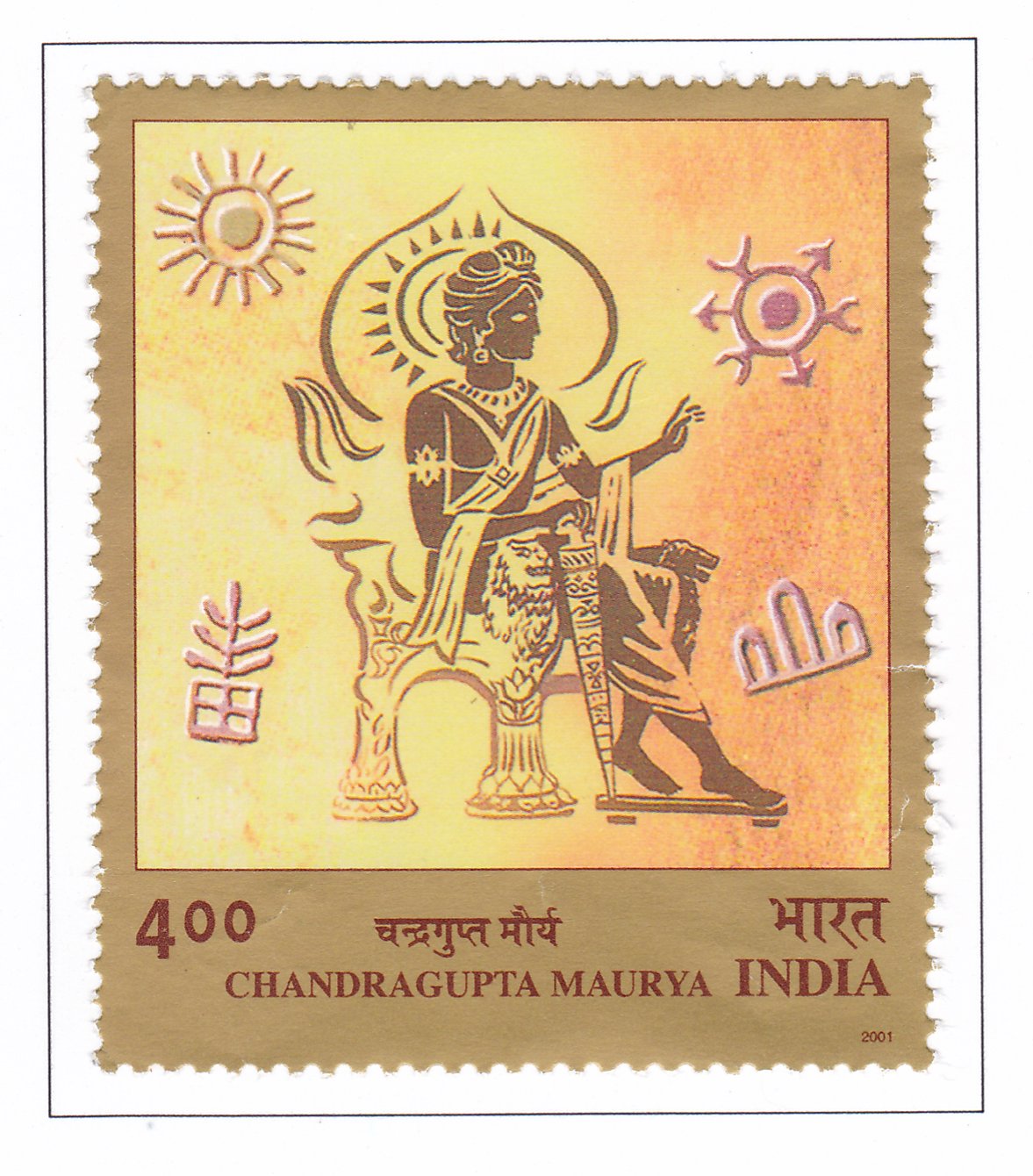Emperor Chandragupta Maurya

Technical Data
| Date of Issue | July 21, 2001 |
|---|---|
| Denomination | Rs. 4 |
| Quantity | 3,000,000 |
| Perforation | comb 13½ x 13 |
| Printer | Calcutta Security Printers Ltd |
| Watermark | No Watermark |
| Colors | Multicolor |
| Catalog Codes |
Michel IN 1840 Stamp Number IN 1899 Yvert et Tellier IN 1606 Stanley Gibbons IN 2006 |
| Themes | Commemoration | Emperors | Famous people | Men |
Table of Contents
Chandragupta Maurya
Chandragupta Maurya (321-297 B.C.) is widely regarded as one of the most prominent and visionary rulers in ancient Indian history, responsible for founding the Maurya Empire, which became one of the largest and most powerful empires in India. His rise to power and establishment of a vast empire laid the foundation for a centralized and well-organized state.
The Rise of Chandragupta Maurya
- Overthrow of the Nandas: Chandragupta emerged during a time when the Nanda dynasty ruled over Magadha, a region rich in resources and strategically located. Despite his humble origins, he managed to overthrow the powerful Nanda king, Dhana Nanda, with the guidance of his brilliant advisor, Chanakya (Kautilya). Chanakya, a master strategist, played a crucial role in Chandragupta’s rise, and together they laid the groundwork for the Maurya Empire.
- Use of Strategy over Force: Though Chandragupta lacked a strong military force initially, he utilized Chanakya’s strategies to outmaneuver the Nandas. This alliance allowed Chandragupta to secure the throne of Magadha in 321 B.C., marking the beginning of his illustrious reign.
Expansion of the Maurya Empire
- Vast Empire: Chandragupta’s conquests expanded the Maurya Empire to include regions such as Bihar, Orissa, Bengal, western India, north-western India, and the Deccan. His empire stretched from the Himalayas in the north to the Deccan plateau in the south, encompassing almost the entire Indian subcontinent, with the exception of Kerala, Tamil Nadu, and parts of the northeast. The Maurya Empire even controlled territories in the north-west that were not part of the later British Empire.
- Strategic Geographical Control: Magadha’s position along the Ganges plain and access to river trade, fertile lands, forests, and iron ore deposits enabled Chandragupta to build a strong economy and military. These resources were critical in the growth of the Maurya Empire.
Governance and Administration
- Efficient Administrative System: Chandragupta is credited with establishing a well-organized and effective administrative system. His empire had a strong financial foundation, thanks to an efficient tax collection system, particularly through land taxes, which funded the empire’s army and infrastructure.
- Advisor and Policies: Much of Chandragupta’s success in governance can be attributed to Chanakya’s political and economic insights. The Arthashastra, authored by Chanakya, outlines many of the administrative and statecraft policies that helped shape the Mauryan empire’s governance.
- Subject-Centric Rule: Chandragupta is said to have ruled with the philosophy that the happiness of his subjects was paramount to his own happiness, ensuring that their well-being and contentment were his priorities.
Personal Life and Jain Influence
- Adoption of Jainism: Later in life, Chandragupta is believed to have embraced Jainism, influenced by the Jain saint Bhadrabahu. Following Jain principles of asceticism, Chandragupta is said to have abdicated the throne in favor of his son, Bindusara, and retired to pursue a spiritual life.
- Abdication and Death: After abdicating the throne, Chandragupta is believed to have migrated to Shravanabelagola in present-day Karnataka, where he spent his remaining years practicing severe austerities and eventually passed away.
Legacy
- Enduring Impact: Chandragupta Maurya’s achievements in uniting large parts of the Indian subcontinent, creating a robust administrative system, and fostering economic prosperity set the stage for the future success of the Maurya dynasty, particularly during the reign of his grandson, Ashoka the Great.
- Historical Significance: His reign is documented in various sources, including Megasthenes’ “Indika” and the Arthashastra. Chandragupta’s legacy as a ruler who combined military prowess with astute governance and a deep concern for his people’s welfare continues to be celebrated.
Commemorative Stamp
The Department of Posts’ issuance of a commemorative stamp in honor of Chandragupta Maurya recognizes his remarkable achievements as one of the most formidable rulers in Indian history. His visionary leadership and contributions to the political and administrative frameworks of ancient India remain influential to this day.
Chandragupta Maurya’s reign, marked by both military conquest and administrative reforms, remains a significant chapter in the history of India’s imperial past.
